Interview with Britt Merrick

Britt Merrick is the lead designer and shaper at Channel Islands Surfboards, shaping and developing boards for some of the best surfers on the planet. The son of Al Merrick, Britt has been around surfboards and surfers his whole life. He's responsible for some of the most popular shortboards of recent years like the Sampler, Black and White, and most recently the Happy. We were excited to talk to Britt and ask him about all things Channel Islands.
Do you remember the first board you ever shaped?
I do. In fact, my wife and I were just looking at it the other day. We have it at our house in the barn. It was a 6’9”, sort of pinned out thruster. Sort of like a pintail. Back then, and this was in the late ’80s, I was kind of into the whole soul surfing thing. So it was like way longer and narrower and more pin-y than your normal thruster during the time. And dude it was terrible. It was so bad.
Haha well, that answers the follow-up question.
It’s so bad. We just found it the other day in the barn and I pulled it out. My wife was like “ we should hang this in the house” and I was looking at it like no…hahah.
But, I loved that board, I rode it the entire winter at Rincon that year and I loved it. Of course, it was terrible, but I learned a lot about craftsmanship and a personal connection with making your own gear. You know? Making your own boards and the stuff that you’re into. That’s what really hooked me into shaping, was riding that board. Because I shaped it, I was committed to figuring out how that board wanted to work. But yeah...it was actually terrible.
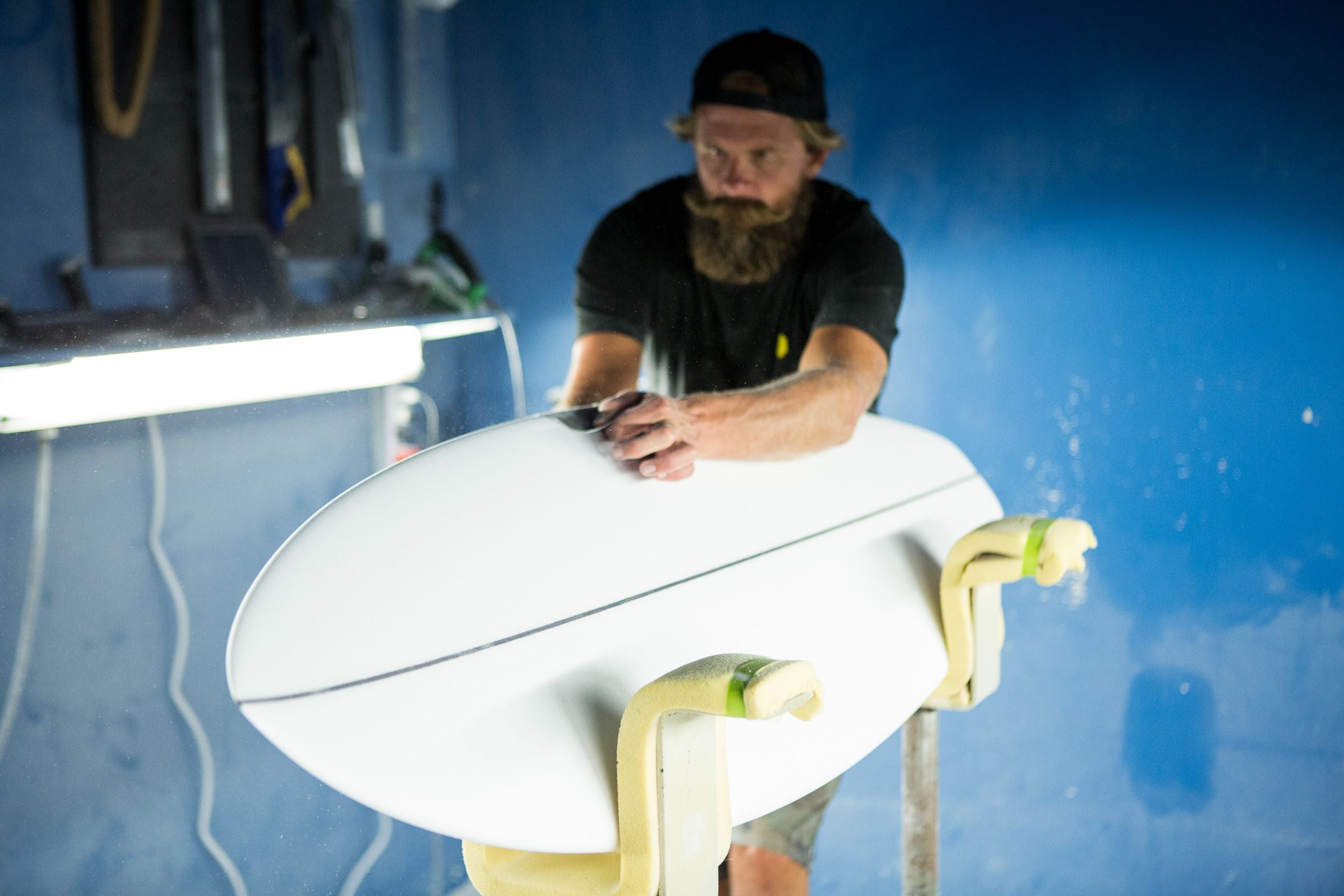
What’s the most important piece of shaping advice you’ve ever received?
Well when my dad was teaching me, he told me that my hands had to be like water. So obviously, shaping is hydrodynamics, right? There’s science involved to it but there’s also art, it’s also like sculpting. There are things you won't necessarily measure or see, but you can kind of feel and discern with your hand and with your tools. So he taught me that my hands and my eyes were to be like water moving over the blank. How does that water want to move across that board to make it do what you want it to do? I think that was the most important piece I’ve ever received.
Is there a specific board or model you’re most proud of?
You know, I’m not really nostalgic. I’m always most excited about what I’m working on currently. I’m almost excited about what I’m working on currently. That’s always what I’m most stoked about. I was just working with Parker Coffin today and we’re working on a new shortboard.
Dang that sounds cool.
Yeah, it’s called the Two Happy, it’s our next shortboard. I’m really excited about that, we’re working on it and making a lot of progress. We were talking about different boards that each of us have been riding and I realized; I only really like riding a board these days, a few times. Since I’m so into progression and every board I make myself, I’m always trying something or I’ve done a tweak or am trying to figure something out, and after a few surfs I have that figured out. As soon as I do, I’m over that board and move on to the next tweak.
So I think that’s kind of showing me that I’m not real nostalgic or interested in what I’ve done in the past. I’m always most excited about what’s right in front of me. So that shortboard I’ve been working with Parker I’m really excited about. I’ve been working really hard with Mikey February on this twin fin called the “Twin Pin”. It’s a pintail twin fin with a Vee Bottom and we designed a fin for that board in particular. I’m super excited about those things and feel proud about them right now.

I think it’s noteworthy that behind the scenes at CI there are a lot of employees who worked there for a long, long time. What do you attribute that longevity to?
Well, honestly we love surfboards and we love surfing and we love surfers. So for us, it’s not just a job, it’s like a real passion. The thing that is so cool about surfing is that is can be a lifelong passion, you know?
Yeah for sure.
It’s not like a sport you can only do through college or something like that. Your body doesn’t necessarily wear out from it, or it’s not like the same court that you’re playing on every time. Every time you go out and surf it's brand new. Every board, even as dialed as we have them, is still a mystery. There are still all these nuances and differences and things going on. It just holds your attention forever.
So I think we’re all really passionate about surfing and surfboards. So we’re just like “this is what we want to do”. Yeah the guys I work with every day have been here 20, 25 years.
There's a lot of great shapers within Channel Islands like Mike Andrews, and Mike Walter. How do you guys divvy up the work? Like if a Sampler just came through would it be like “Yeah sweet I got that. Fever up next, Mike’s on that". Or is it like luck of the draw?
No, it’s all very orchestrated. We have quite a few shapers beyond those guys, so a lot of our other shapers will do most of the stock boards. We have certain shapers that do a lot of the custom boards and then myself and the other guys will predominantly do team boards.
Team boards and development. Usually, a certain surfer works with a certain shaper. To us, that relationship is really important. Like developing a common understanding around boards and how to progress the designs and what the surfers want to do. So it’s all really calculated and intentional.

What do you think makes the AM template fin so good? Pretty crazy to see how many people ride it, both pros on tour and everyday surfers.
Yeah, I’ve been told that it’s the best-selling thruster set in the world. I don’t know if that’s true or not… My dad developed that fin around Rincon. It was in the early '80s when he first started working on that. A lot of the fins were kind of morphing out of twin fins. So they were more upright in nature than that fin ended up being. But my dad, surfing the long walls at Rincon realized he wanted a fin on his thrusters that had a bit more rake. So you could get more drive down the line and then hold your turns for longer because we’re surfing Rincon. That fin really began to diverge from the normal, again thrusters that at the time in the ‘80s were more upright, and it got more raked back. But then he realized he wanted a little more release out of the tip of the wave. So that’s why the back fin is smaller than the front fins. So it's a really good combination between, drive, hold, and release.
Is there a sleeper CI model that comes to mind, one that might not be in the lineup anymore that still has a cult following and you think deserves a re-examining?
Thaaat’s a good question….That’s a good question, I mean I think there’s a lot of those throughout history. Currently, the Ultra Joe. That board is amazing.
Huh really?
Dude. That board is sooo fast, like freaky fast and loose. Works best as a quad. I definitely suggest that you ride it as a quad. That board is so fast, loose, and easy to ride it’s crazy. I think it’s in our top...maybe like our 5th bestseller or something like that?... but I don’t think it does nearly as well as the board actually surfs. I don’t know if it's the aesthetic that people aren’t into or what?... But that board’s crazy.
The other one that surprises me that it doesn’t do better is the Neck Beard 2.

Woah I thought that would’ve been one of the best sellers? Definitely a shop favorite.
I mean it's like be our 4th best-seller or 5th... or somewhere around there... But I think way more people should be riding that board. In anything under head-high, that board is insane. I can’t even get Dane Reynolds to ride anything else until it’s overhead. That’s all he rides.
I’m actually working on a Neck Beard 3 version of that, where I’ve changed the tail and put in a round tail on it. I think a lot of people are just kind of intimidated by the big square tail.
It's interesting how well that square chop tail works.
Yeah! It looks a little intimidating but if you ride it, it’s pretty seldom that the tail is actually a liability. So, we’re coming out with Neck Beard 3 which will have a round tail on it, which I think is a little softer aesthetic for people. But I also think it will make the board a little more versatile and broad for people.
To what extent are existing models works in progress? It seems like they’re getting tweaked over time and updated. Like a Dumpster Diver from 2010 looks different than the ones, we get today. Could be my imagination but like the older ones had more ears to it?
No, you’re right.
Hah! But are all the boards in a constant state of development? Like even the older models are getting refined over time.
Yeah totally, everything is always onboard. Like we’re always working on all of it. Our philosophy is the surfers dictate the designs. Like what does the surfer want to feel? Even though the design might be great, eventually, it starts to feel a little stale and you want to feel something new. Or they’ve ridden the board for so long they realize “gosh, it’s kind of got this glitch I never realized before” or “I kind of want it to roll over on rail a little easier”. So we’re always tweaking, always, always tweaking.
Well, that’s really cool.
Yeah and that’s part of the fun, like I said I don’t even like to ride a board more than a few times because I want to tweak it. You know what I mean? That’s part of the fun and part of the passion and the pursuit. I think that’s equally as rewarding for the surfer as it is the shaper.

Channel Islands is known for being a custom shop and being able to make just about any board for any surfer, have you ever had to draw the line on a custom? Like it was too wild or impossible to make?
Well, our philosophy is that we don't draw the line. We’ll make anything that you want and we love it when our customers dream. Like our board builder on our website is so rad, you can do whatever you want. You can add any feature you can think of and do all of these different things. We just get super stoked when customers go and just dream and become the designer and we’ll make it.
Now if something comes across our desk so to speak, that we’re just like “dude that is not going to work”, we’ll pick up the phone and call the customer and we’ll have a conversation. We’ll be like “Hey, tell us what you’re thinking about this. I’m not sure about this...” and we’ll just try to come to a solution. That’s pretty rare. Most of the time, we’re stoked to see what people come up with and amped to make it.
The response to Spine Tek has been really good from what we’ve seen with employees and customers, how did you decide on that construction?
Now we have these partners in Australia, who are great called Shapers. It’s a great company, they make a lot of our shaping tools, a lot of our supplies, a lot of our different cloths and carbon fiber weaves and stuff like that. They were working on developing that technology and presenting it to us. We partnered with them and ended up developing it. It just achieves what you want it to achieve. What you want to do, is you want to have the most positive characteristics of EPS foam and epoxy resin construction without some of the liabilities. Some of the liabilities are that it can get chattery you know? Or the resonant frequency of the vibration can be a little too high. So the spine works as a damper that kind of tones down that vibration frequency a bit but it also harnesses kinetic energy, like stored energy. So when it flexes it stores energy so that when it releases, you get that incredible pop. So now we upped the EPS equation. What we like about it, we just made that better, we got rid of some of the liability and we’ve made it last longer. Because there’s not a wood stringer that wears out and the foam doesn’t break down as quickly and it’s flex characteristics because this spine had this incredible resiliency and lifespan to it. The boards just outright work and they last longer as far as maintaining their flex characteristics, which is a huge part of how a surfboard works. They’re not necessarily more durable than another board, it’s just that they hold their flex characteristics longer. That’s why you’ll have a favorite board and all of a sudden it’ll die?
Well, that’s because the materials have broken down and it’s lost its resiliency to its flex and its spring and pop. So this just maintains this much longer than normal construction.
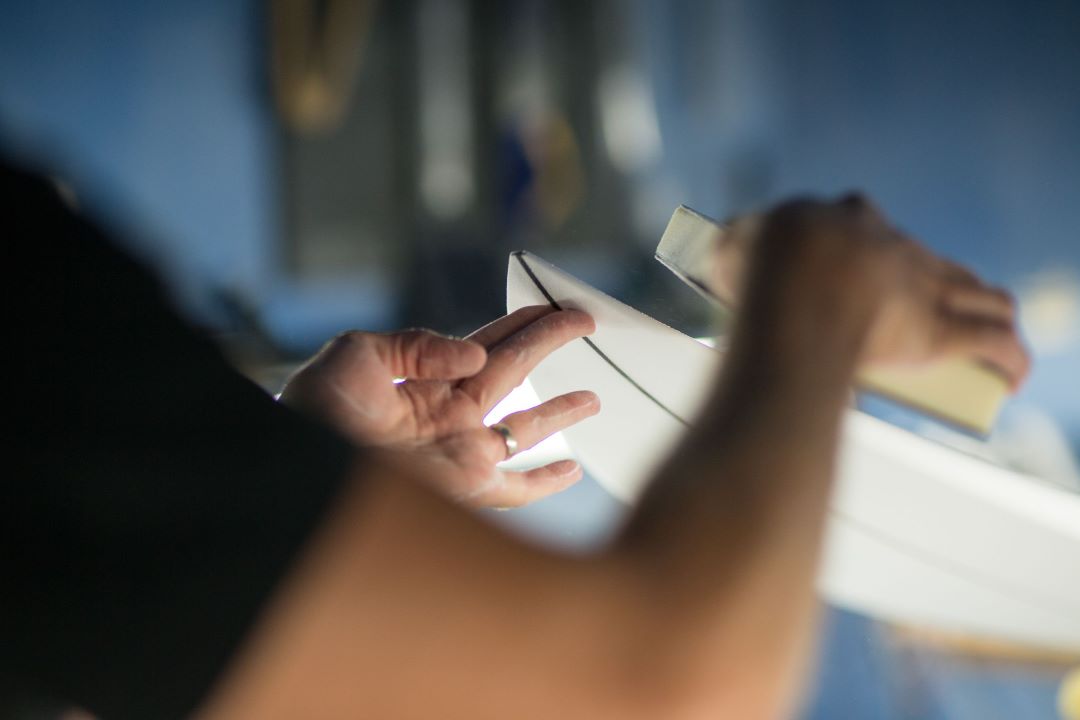
Who have been the most challenging surfers to shape for?
The hard surfers are the best ones.
More feedback?
Yeah, they’re the ones that push you and that’s what you need. So there’s a lot of surfers that I shape for that pretty much like most of every board and it’s going great for them and that’s awesome and rewarding. I don’t know that I would have the energy if everybody was difficult. There are other surfers that are hard to please and they’re very particular and it’s not even like a character defect from them... It’s just that they’re that tuned in to their equipment that they can really tell what’s going on and they demand that everything is going right. I love that.
That really forces you to up your game. Dane is super notable there. Nobody is more tuned in to a surfboard than Dane and more particular and that’s been really helpful. I’ve been working a lot with Bobby Martinez and he’s very particular and demanding. He’s not quite as tuned in to as why a board might be or not be working. He doesn’t really know that, but Dane can really tell you “I think we need to tweak this or tweak that” and that’s fun.
Yeah, it was crazy watching the "Stab In The Dark" Series with him, where he was testing boards. Listening to his board feedback, it was so specific and critical. He'd be like " I think the rocker breaks too soon”.
Yeah exactly.
Alright, last question, where have you been drawing inspiration for design as of late?
From the surfers that I’m working with really. Like I said I’m really excited about this Twin Pin that I'm doing with Mikey February, and that just comes from his aesthetic and the lines he likes to draw on a wave, what he wants to feel. He kind of led the way on that, and it really all comes from the surfer. I’ve been working on twin fins with Tom Curren and I’m learning a ton there. That’s where I draw inspiration from a surfer whether it’s at the beach surfing on in the shaping bay talking together. We try to let them lead the way, ya know? Our philosophy is we want to serve the surfer. What does he or she want to feel? What is their dream? What do they want to experience? Our job as surfboard builders is to make their surfing dreams come true. Surfers are what inspire us.
Final Thoughts
We’ve proudly been carrying Channel Islands’ boards for over 30 years and have had countless magic boards come through for team riders, customers, and employees alike. If you’ve never ridden a Merrick or haven’t checked out their recent offerings be sure to check out our lineup, you won't be disappointed.
Huge thanks again to Britt for taking the time to answer our questions, and special thanks to Tyler from CI for setting it all up.
If you're up for more reading, take a look at our review of the 2022 CI Pro Surfboard.
SHOP OUR ENTIRE SELECTION OF CHANNEL ISLANDS SURFBOARDS
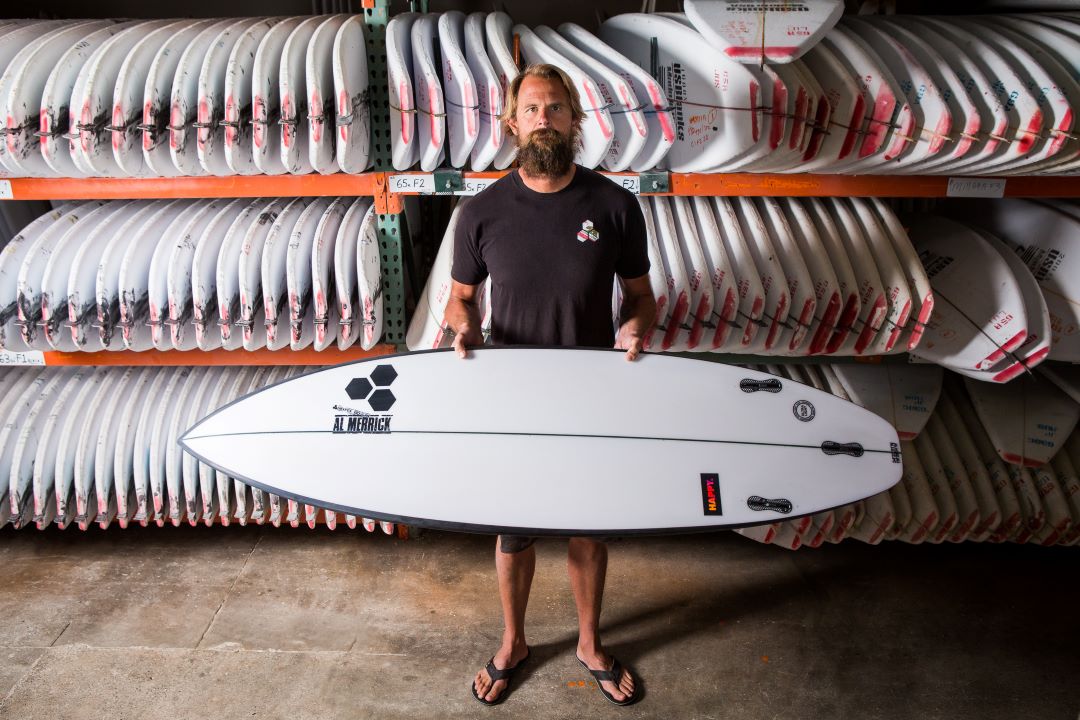


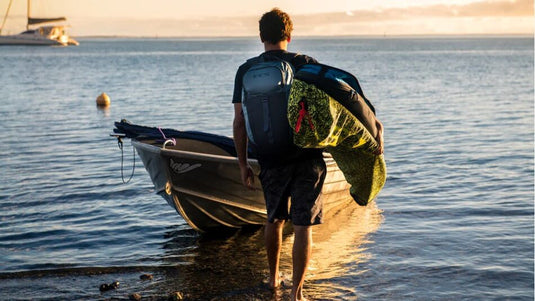






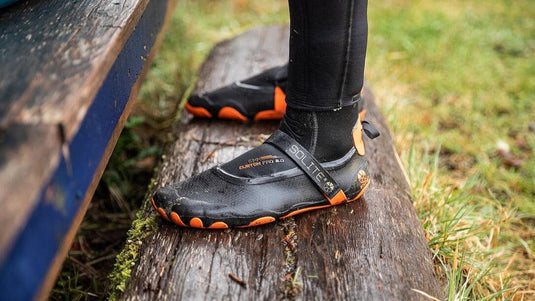



What Our Customers Are Saying